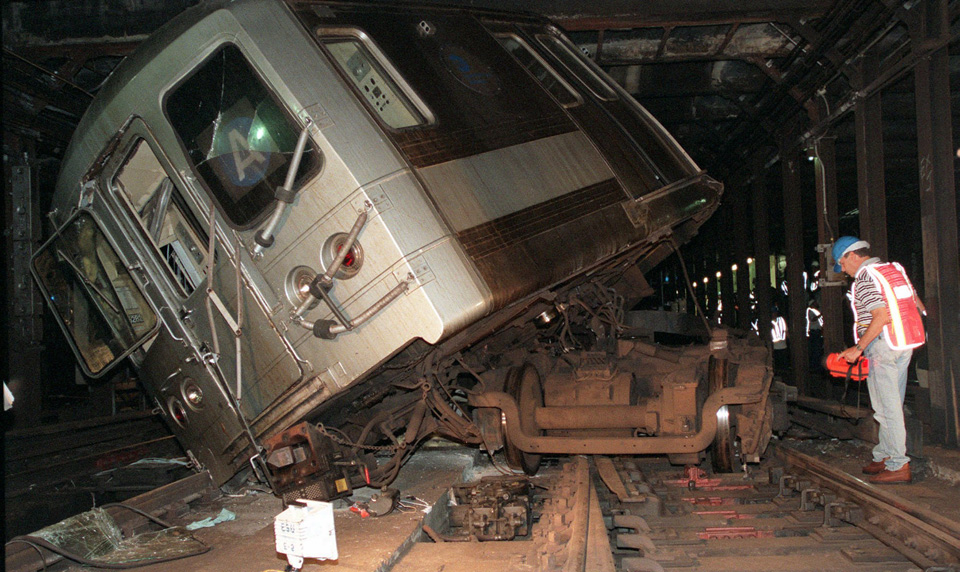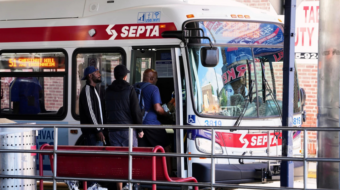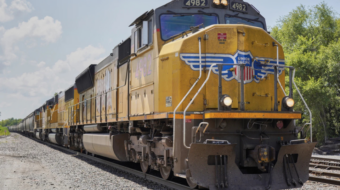
NEW YORK – What do greedy real estate titans like Donald Trump have to do with turning what would be a 10-minute car ride into an hour-long ordeal for a public transit rider? A heck of a lot, if you hear the cry coming from a rising protest movement all over New York State.
The problem, riders say, is caused by declining investment in public transit resulting from tax breaks and giveaways instead to big real estate tycoons like Donald Trump and finance capitalists on Wall Street.
In Buffalo, what would be a less-than-10 minute car ride turns into a near-hour ordeal schlepping between buses. Low-wage workers without cars find themselves slashing their own paychecks by taking cabs to work. In New York City, subway delays and re-routes can double or triple commuting times for people already being squeezed by rising rents charged by those real estate tycoons.
New York City residents held a rally outside Gov. Cuomo’s city office June 28. It was called by Communities for Change (NYCC), the Riders Alliance, and the Straphangers Campaign, a product of the New York Public Interest Research Group.
“I’m sick and tired of the way the system is run – the late trains, the dirty trains,” Norman Fraser of NYCC told the People’s World. “It’s just ridiculous … pay[ing] so much of our money for service we don’t even get.”
The next day, Buffalonians with the Coalition for Economic Justice (CEJ) and the Buffalo Transit Riders United (BTRU) met to watch a documentary about the Bus Riders Union in L.A. to garner ideas on how to fight back against bus line cuts.
In L.A., city buses which working-class and mionority communities relied on were neglected while commuter trains to outer suburbs got special treatment. After a long battle, the Bus Riders Union finally won 532 new clean-air buses for the people of Los Angeles.
The 23-member board of New York City’s MTA is 100 percent white and includes only three women. Gov. Cuomo appoints all of its members. Four are recommended by the mayor of New York City and seven by county executives from Orange, Nassau, Suffolk, Westchester, Dutchess, Rockland, and Putnam counties – all Republican and all outside of New York City. One is recommended by the Metro-North Railroad Commuter Council. Transit unions and councils representing commuters on NYC’s subways and buses, and the LIRR are also able to recommend board members, but these are not allowed to vote on the board’s decisions.
The fight for better public transit is very much connected to the struggle in New York against the big real estate titans. On June 21 Cuomo appointed Joseph J. Lhota to chairmanship of the MTA’s board to address the unacceptable “level of service and daily frustrations” commuters experience. “I know Joe will move to address these issues immediately and ensure a reliable and effective transportation system worthy of the city it serves,” he said.
Lhota is a former Republican candidate for mayor. In 2013, the New York Times pointed out he had “amassed a fortune of at least $13 million from real estate and investments.”
While the governor and representatives outside the city control MTA operations, they also receive millions in real estate campaign contributions. Gov. Cuomo and Jeff Klein, leader of the Independent Democratic Caucus (IDC), which votes with Republicans in the state Senate, are the biggest beneficiaries of campaign donations coming from real estate developers. In exchange for lining the pockets of the legislators the developers get billions in 421-a money, essentially a tax break for building luxury condos in working class neighborhoods. Cuomo has even refused to return any of the $64,000 donated to him by Donald Trump, who owns over $2 billion in New York real estate.
Real estate-backed GOP and IDC New York State Senators Terrence Murphy, David Carlucci, and Sue Serino, elected to represent Westchester, Rockland, and Dutchess counties, led the charge on June 7th to axe the Metropolitan Commuter Transportation Mobility Tax (MCTMT). This year, the MCTMT would add $1.4 billion dollars to the MTA budget with a 0.11% – 0.34% tax on employers that benefit from the infrastructure and that put more than $312.5K towards their workforce.
The governor has the power to work with the mayor to raise taxes on Wall Street, which has foreclosed on 5.5 million homeowners since crashing the world economy in 2008. Instead, he has tried to blame the mayor for the MTA’s problems, saying the city should pay more. The city, which hosts Wall Street, already contributes most of the MTA’s funds. In 2014 the city contributed over $10.1 billion to the MTA, while New York State contributed $603.5 million. In the face of public transit decline, Donald Trump has proposed over $2 billion in cuts to the state’s transit budget. He has also proposed $7.4 billion in cuts to public housing and section 8 nationwide.
As one reporter at the protest rally noted, the governor’s office has said his “is the most robust capital plan and the largest budget capital plan in MTA history.” The defense bears a curious similarity to the excuse the Governor has used for failing to make good on the $3.9 billion dollars still legally owed to New York State public schools per the 2006 Campaign for Fiscal Equity ruling.
Those at the rally found the argument unconvincing. “For decades New York has been trying to fix public transit on the cheap,” said John Raskin of the Riders Alliance. “If the capital plan were sufficient our subway system would be on the mend instead of falling apart.”
Vaughn Armor of NYCC told the cameras, “We need to modernize our subway system, and take the money [from] these billionaires and millionaires and Wall Street getting a break and put it in our subway system now!” “It’s a shame that New Yorkers have to play Russian roulette when they get on the train or bus” and “don’t know if you’re gonna get there or not,” said Armor. “What’s next? Maybe a tunnel might fall in or something!” The rally was held the day after an A-train in Harlem derailed and careened into a wall.










